

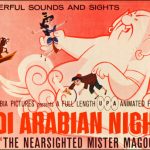
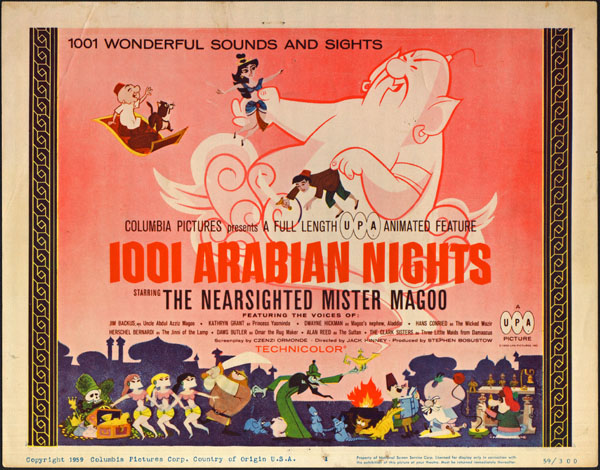
During the late 1940s and early 1950s, United Productions of America (UPA) was the most critically acclaimed animation studio in the United States. The conventions of modern abstract art, featuring flat graphics, minimalist animation, and a striking use of color and design, made UPA a worthy alternative to Disney Studios’ realism.
Well-recognized stars of animation such as John Hubley, eventual studio head Steven Bosustow, Jules Engel, Bill Hurtz, Pete Burness, and Bob Cannon rewrote the rules of animation during their distinguished careers at UPA. Extraordinary shorts, such as Rooty Toot Toot, The Tell-Tale Heart, The Unicorn in the Garden, and Gerald McBoing Boing, won UPA (and their distributor, Columbia Pictures) awards and acclaim.
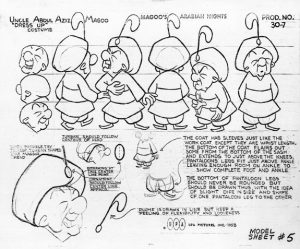
Click To Enlarge
The studio had planned a feature film as far back as 1946 and, over the next ten years, considered subjects such as Ben Johnson’s Volpone, a James Thurber feature film, Cervantes’ Don Quixote, Gilbert and Sullivan Operettas, and Helen of Troy. Not until 1957 did writer Ted Allan submit a treatment titled “Mister Magoo’s Arabian Nights” (Steve Bosustow decided as early as 1953 that any feature would star Magoo, including Don Quixote). A later draft by Czenzi Ormonde sealed the deal with Columbia.
Unfortunately, by the time the feature commenced production in early 1958, UPA was on its last legs as a creative entity and lacked the resources to tackle the project. As the end of the fifties neared, UPA had lost three satellite studios, the loss of Columbia Pictures’ distributorship, and the TV cancellation (twice) of The Boing Boing Show. By 1959, nearly all their founders and leading lights were gone. The loss of artists and other talents, combined with UPA’s other troubles, doomed the project from the beginning.
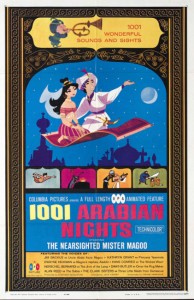 Pete Burness was tabbed to direct the Magoo feature but clashed with studio head Bosustow and departed UPA. Bosustow reached out to ex-Disney director Jack Kinney (famous for directing the 1943 short Der Führer’s Face and his hilarious Goofy sports shorts. Kinney, aware that most studios were closing their animation departments at the time, was able to hire many established animators now seeking work.
Pete Burness was tabbed to direct the Magoo feature but clashed with studio head Bosustow and departed UPA. Bosustow reached out to ex-Disney director Jack Kinney (famous for directing the 1943 short Der Führer’s Face and his hilarious Goofy sports shorts. Kinney, aware that most studios were closing their animation departments at the time, was able to hire many established animators now seeking work.
Phil Ducan, ex-Disneyite who had worked with Frank Tashlin at Columbia-Screen Gems came on board. Rudy Zamora, who would later be involved in over twenty TV animation projects, had worked in nearly every major animation studio. Harvey Toombs, Ken Hultgren, Bob Carlson, Javk Campbell, and Herman Cohn also contributed. Also present was animator Jim Davis, who had a regular gig drawing DC Comics Fox and Crow comics.
Abe Levitow, one of Chuck Jones’ most notable collaborators at Warner Bros., was hired as animation director. (Levitow became the film’s de facto director, according to one animator). This arrangement ensured that the Arabian Nights feature would have a varying look and tone compared to the “classic” UPA style, despite Production Designer Robert Dranko’s efforts to preserve it.
Jack Kinney recalls that upon his arrival, “Considerable work had been done on the feature, but it was a mess.” Facing what he called “a very skimpy budget” (estimates suggest $1M), Kinney soldiered on and pulled the pic together just in time for the 1959 Christmas season, suggesting a very rushed and chaotic production schedule lasting slightly under one year.
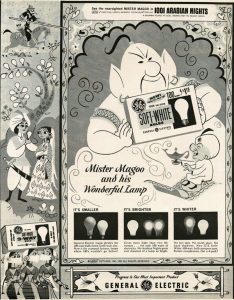 The voice cast may have been the most talented people in the film. Foremost was Jim Backus as the voice of nearsighted lamp salesman Abdul Aziz Magoo. Magoo was a character Backus would play for decades. Dwayne Hickman (TV’s Dobie Gillis) voiced Magoo’s nephew Aladdin, and Kathryn Grant (Mrs. Bing Crosby), portrayed Princess Yasminda. Alan (the future Fred Flintstone) Reed played the Sultan, and the ever-reliable voice artist Daws Butler starred as Magoo’s buddy Omar the Rug Maker. Add Herschel Bernardi as the Jinni of the lamp, and a great cast is on hand.
The voice cast may have been the most talented people in the film. Foremost was Jim Backus as the voice of nearsighted lamp salesman Abdul Aziz Magoo. Magoo was a character Backus would play for decades. Dwayne Hickman (TV’s Dobie Gillis) voiced Magoo’s nephew Aladdin, and Kathryn Grant (Mrs. Bing Crosby), portrayed Princess Yasminda. Alan (the future Fred Flintstone) Reed played the Sultan, and the ever-reliable voice artist Daws Butler starred as Magoo’s buddy Omar the Rug Maker. Add Herschel Bernardi as the Jinni of the lamp, and a great cast is on hand.
But the real show-stealer was Hans Conried as the Sultan’s wicked Wazir, a sneaky, slick, and slimy villain with a host of loving vermin as pets. Critics never failed to point out Conried as the film’s highlight.
The film did not remain in theaters for long. Reviewers were more indifferent than unkind. Despite several high notes, there are not nearly enough of them to elevate 1001 Arabian Nights to either classic or cult status. It remains a pleasant, mildly entertaining time-filler that leaves serious animation fans wondering what UPA might have accomplished with its whole, original staff and more sophisticated material. Instead, the film marked the virtual end of UPA as an animation studio.
To take this flashback full circle: In 1965, NBC bought a prime-time series called The Famous Adventures of Mister Magoo. Those who followed the short-lived program enjoyed a two-part episode where Quincy Magoo gave a sterling performance as… Don Quixote!
NOTE: This piece is an edited version of an article I did for the Fall 1998 issue of TOON Magazine.